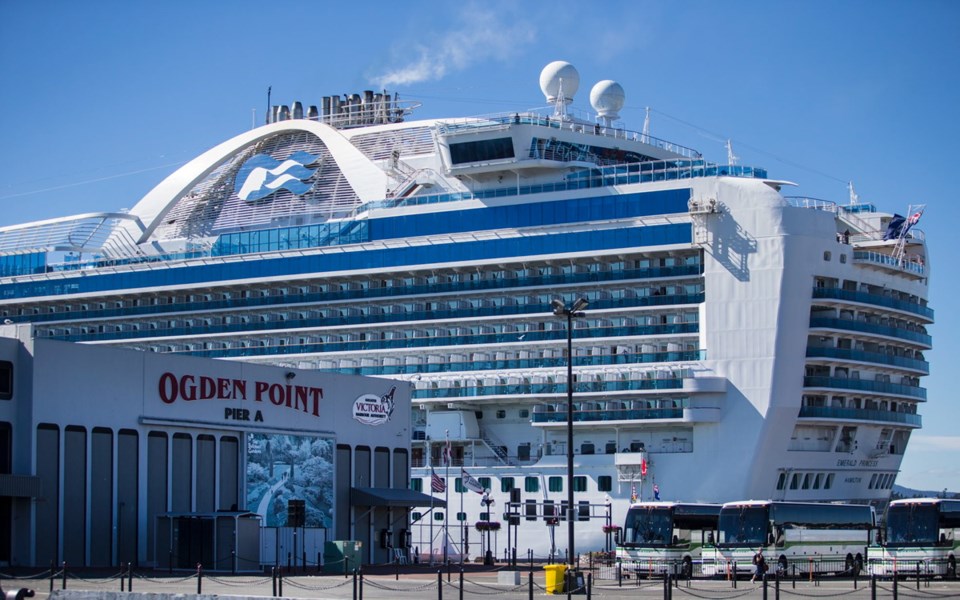Cruise ships won’t be returning to Victoria this summer, to the disappointment of hundreds of businesses that rely on passenger spending.
Transportation companies, restaurants, attractions and tourism operators will all feel the squeeze after the federal government extended its ban Thursday on large cruise ships visiting Canadian ports until February 2022.
Federal Transportation Minister Omar Alghabra cited the recent surge in COVID-19 cases, including new variants of the virus, saying the government has an obligation to protect Canadians and avoid overwhelming health-care systems.
“This is the right and responsible thing to do,” Alghabra said.
Simone Kearney, who sells souvenirs to cruise passengers at Ogden Point and now through a pop-up at Mayfair Shopping Centre, called the extended ban a gut punch, saying she’s stuck with a warehouse full of products Canadians won’t buy.
“I was expecting a return of the ships, maybe in August, but now I don’t have words … I feel ill,” said Kearney.
The ban affects cruise ships with more than 100 passengers, wiping out a second full season of ships at Ogden Point and crippling the bottom line for the Greater Victoria Harbour Authority, which expects to see losses surge to $25 million.
The authority had been expecting more than 300 ship calls this summer, but those numbers started falling last month, when cruise companies anticipating further restrictions started re-evaluating sailings amid the pandemic.
In May 2020, when the first ban was announced, 300 ship calls were also cancelled, scuttling a season that had been forecast to bring nearly 800,000 passengers and an estimated $130 million in economic activity to Greater Victoria.
Chief executive Ian Robertson said the harbour authority earns 70% of its annual revenue from the cruise industry and will now have to look at other ways to cut costs across the properties it manages, including Fisherman’s Wharf, the Inner Harbour Causeway, Ship Point and numerous harbour docks.
“The first words out of my mouth today was: ‘Wow, what a body blow,’ ” Robertson said Thursday.
“On one hand, it’s the right thing to do. The health and safety of the community, and the efforts made to reduce the spread of COVID-19, remain our top priority,” he said.
“On the other hand, it’s another season without cruise ships and I’m thinking about all those small businesses and operators who rely on it. It will be tough for them.
“We hope that many of these businesses will survive the coming months until the resumption of cruise is permitted.”
Jill Glowicki, who operates seven tourist stores along Government Street with business partners, called the cruise ban “heartbreaking.”
“It will be really tough for us to survive without those passengers, and with the [U.S.] border closed,” said Glowicki, whose souvenir stores include Spirit of Victoria and Moose Crossing. “The only way for us to pull through will be with government assistance on wages and rent relief. Otherwise it’s impossible.”
Glowicki said the cruise industry represents 50% of the stores’ annual sales. Visiting Americans via airlines and ferries from the U.S., which are also on hold, account for a further 40%. “So we’re 90% down. You can’t keep that up.”
Paul Nursey, CEO of Destination Victoria, which markets the region, said the move is not unexpected, but it means the ban will have spanned two full summers and three off-seasons, a big blow for tourism businesses struggling to survive.
He said other tourism-dependent jurisdictions have seen more effective vaccine rollouts and rapid testing. Canada is “performing poorly” in that regard, he said, which means other destinations will likely open safely much quicker, and steal away tourism spending.
“In the long term, we could lose capacity, businesses and vital transportation infrastructure,” he said, pointing to suffering bus systems and idle U.S. ferry lines.
Nursey said travel could be safely reopened with massive vaccinations and rapid testing that would allow bubble groups to travel to places like Victoria and the rest of the Island.
Meanwhile, the cruise-ban extension means the harbour authority will add at least another $12.5 million loss to its books, about the same amount it lost after the 2020 cruise season went down the drain.
The authority has already had a permanent reduction of staff in some departments and moved to essential-service status in its operations. Contracts with several local businesses have also been cut or reduced and all capital projects are on hold.
Robertson said he expects further cuts to services. One of the first things Victorians will notice is reduced landscaping throughout the Inner Harbour: It has already decided not to plant the big Welcome to Victoria garden on the south side of the Lower Causeway.
Many events deemed safe to operate under provincial health orders will also be cancelled due to the authority’s inability to dedicate staff time or financial support.
Cruise Lines International Association, which represents cruise companies operating in Canada and the U.S. Pacific Northwest, said it was surprised by the length of the government’s no-sail order.
Chairman Charlie Ball said in a statement that the industry hopes to have an opportunity to revisit the timeline and demonstrate its ability to address COVID-19 in a cruise setting with science-backed measures, as its members are doing in Europe and parts of Asia where cruising has resumed on a limited basis.
The federal government has advised Canadians to avoid all travel on cruise ships outside Canada until further notice.



